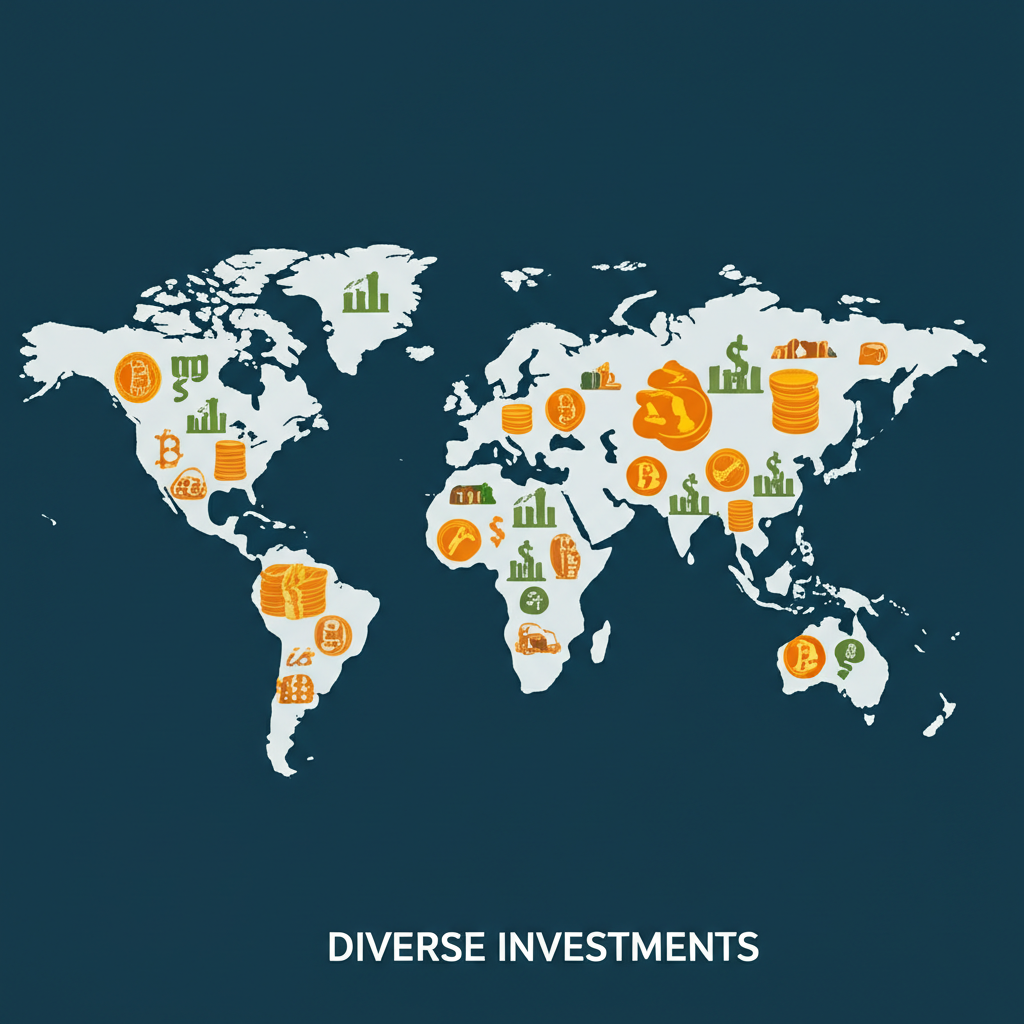Introduction: Why Middle East ETFs Are Gaining Traction for United States Investors in 2025
The Middle East has long been recognized for its abundant energy reserves, but today it’s experiencing a major shift toward broader economic development. Countries in the region are pushing forward with bold plans to diversify their economies, build thriving technology centers, and pour resources into large-scale infrastructure. These changes are drawing interest from investors around the world, including those in the United States who want to spread their investments beyond familiar markets. Middle East Exchange Traded Funds (ETFs) stand out as an efficient way for U.S. investors to get involved in this evolving area, especially looking toward 2025. By offering easy entry into high-potential markets, these funds help balance exciting growth possibilities against the challenges that come with them.

Grasping the basics of Middle East ETFs, along with the opportunities they unlock and how to navigate U.S. investment rules, is key to making smart choices. As global markets become more interconnected, adding exposure to the Middle East can strengthen a portfolio’s resilience and open doors to underrepresented growth stories. For American investors, this means not just chasing returns but also building a more robust strategy against economic uncertainties.

Understanding Middle East ETFs: What They Are and How They Work
Exchange Traded Funds, or ETFs, function like baskets of investments that trade on stock exchanges just as shares do. They usually contain a mix of stocks, commodities, or bonds, with prices staying close to their net asset value throughout the trading session. Middle East ETFs zero in on this particular region, giving investors a way to connect with its businesses and economic forces without needing to pick individual stocks.
These ETFs spread investments across sectors that define the Middle East, from established areas like energy and banking to fast-growing fields such as tech, property, and consumer goods. U.S. investors have options ranging from funds tied to one country-think Saudi Arabia or the UAE-to wider ones covering the Middle East and North Africa (MENA) area. This setup lets you customize based on your views of specific markets or your need for broader variety, making it easier to fit into an overall investment plan.
Top Middle East ETFs Available for United States Investors in 2025
U.S. investors interested in the Middle East have access to several standout ETFs that provide straightforward entry into major economies there. Most of these are based in the U.S., so they fit seamlessly into everyday brokerage accounts, just like any other American-listed fund.
iShares MSCI UAE Capped ETF (UAE)
The iShares MSCI UAE Capped ETF (UAE) zeros in on the United Arab Emirates, a country leading the charge in economic variety and international trade. With strengths in banking, real estate, travel, and shipping, the UAE keeps pulling in outside capital. This fund mainly holds big and medium-sized UAE-based companies, giving a clear view of the nation’s progress and future direction. You’ll find ties to major players in the lively scenes of Dubai and Abu Dhabi. Heading into late 2024, it features a solid expense ratio and healthy assets under management (AUM), showing strong appeal for those wanting pure UAE access.
VanEck Vectors Israel ETF (ISRA)
Israel, known as the “Startup Nation,” powers its economy through fresh ideas, especially in tech, online security, and life sciences. The VanEck Vectors Israel ETF (ISRA) gives U.S. investors a clear path into this vibrant space. It focuses on Israeli companies, highlighting the country’s buzzing tech world and strong research efforts. The fund’s results often mirror worldwide needs for advanced tech and Israel’s edge in high-growth fields. For growth-focused portfolios, its expense ratio and AUM are worth checking to see if it matches your needs.
Franklin FTSE Saudi Arabia ETF (FLSA)
As the Middle East’s biggest economy, Saudi Arabia is reshaping itself through Vision 2030, a plan to move beyond oil dependency. The Franklin FTSE Saudi Arabia ETF (FLSA) lets U.S. investors join this big push. It targets Saudi stocks, reaching into areas like banking, manufacturing, materials, and everyday goods as the country builds new sectors and welcomes global money. With its low expense ratio and rising AUM, FLSA is gaining ground as Saudi markets open up more to outsiders.
Global X MSCI Qatar ETF (QAT)
Qatar plays a big role in liquefied natural gas (LNG) worldwide and enjoys one of the highest incomes per person, creating a distinct investment angle. The Global X MSCI Qatar ETF (QAT) opens the Qatari market to U.S. investors, with heavy weighting in energy, finance, and firms boosted by its vast sovereign funds. Though its overall market size is smaller than some neighbors, Qatar’s steady foundation and smart investments make QAT a solid pick for spreading risk. Weigh its expense ratio, AUM, and sector focus carefully.
Other Notable Middle East ETFs for US Consideration
Stepping beyond single-country options, U.S. investors might explore wider regional ETFs or those honing in on particular sectors. Though not as widespread, certain funds touch on the full MENA zone, including places like Egypt or Morocco, or zero in on themes like Islamic finance. Before diving in, confirm that any ETF meets U.S. access rules and compliance standards to avoid surprises.
| Ticker | Fund Name | Primary Country/Region | Expense Ratio (approx.) | AUM (approx.) | 1-Year Performance (as of Dec 2024) |
|---|---|---|---|---|---|
| UAE | iShares MSCI UAE Capped ETF | United Arab Emirates | 0.49% | $300M – $500M | Varies (check live data) |
| ISRA | VanEck Vectors Israel ETF | Israel | 0.61% | $250M – $400M | Varies (check live data) |
| FLSA | Franklin FTSE Saudi Arabia ETF | Saudi Arabia | 0.19% | $150M – $250M | Varies (check live data) |
| QAT | Global X MSCI Qatar ETF | Qatar | 0.68% | $50M – $100M | Varies (check live data) |
Note: Expense ratios, AUM, and performance data are approximate and subject to change. Investors should always refer to the most current fund documentation and live market data. Data as of December 2024.
Strategic Investment Themes & Opportunities in the Middle East for 2025
Beyond its oil heritage, the Middle East buzzes with forward-thinking investment ideas. Heading into 2025, a handful of forces will likely steer the region’s economy and boost the appeal of its ETFs.
Economic Diversification and Vision Initiatives
Leading the charge are sweeping national strategies. Saudi Arabia’s Vision 2030 seeks to cut oil’s dominance by nurturing fresh industries, ramping up tourism, and drawing in international funds. The UAE, meanwhile, cements its role as a worldwide center for business, money, and visitors, building an economy less tied to petroleum. These efforts fuel huge projects like modern cities and economic zones, creating chances outside energy. The World Bank points to steady reforms in MENA, focusing on private business expansion and varied income sources, which could sustain long-term gains.
Innovation and Technology Hubs
The Middle East is stepping up as a global tech contender. Israel, the “Startup Nation,” dominates in cybersecurity, AI, and biotech, backed by lively venture funding. The UAE advances in AI, financial tech, and blockchain to claim regional leadership. Saudi Arabia pours money into digital setups and smart tech via Vision 2030. Such momentum fuels expansion in tech firms, which many ETFs capture, offering U.S. investors a stake in cutting-edge progress.
Key Risks and Important Considerations for United States Investors
The Middle East holds strong promise, but U.S. investors should weigh the downsides of emerging markets carefully.
- Geopolitical Volatility: With intricate politics and tensions, the region faces risks from conflicts or instability that can shake markets quickly.
- Crude Oil Price Fluctuations: Even with diversification, oil prices still sway many economies, hitting budgets and profits during slumps.
- Currency Risks: Shifts in local money versus the dollar can cut into gains, regardless of local asset strength.
- Regulatory Environment Differences: Local rules may lag U.S. standards in openness or safeguards, adding layers of caution.
- Liquidity Concerns: In smaller markets, thin trading could make ETF shares tougher to move at fair prices.
- Concentration Risks: Single-country funds might lean heavily on a few firms or areas, amplifying swings from their performance.
How United States Investors Can Access Middle East ETFs in 2025
For U.S. investors, tapping into Middle East ETFs usually means using regulated American brokerage setups. Funds like UAE, ISRA, FLSA, and QAT are U.S.-based and list on domestic exchanges, so they’re as simple to buy as local ones. Watch the gap between these and any overseas-listed options, which might bring extra rules or tax hurdles for Americans.
Here’s a straightforward path to get started:
- Open a Brokerage Account: Set up with a broker overseen by U.S. authorities.
- Research ETFs: Pick ones that suit your aims and comfort with risk.
- Fund Your Account: Add money to your account.
- Place Your Order: Buy shares via your broker’s tools.
Choosing the Right Broker for Global Diversification in the US
Picking the best brokerage matters a lot for U.S. investors eyeing worldwide reach, including through Middle East ETFs or other global paths. Look at factors like U.S. oversight (FINRA/SEC), user tools, costs, investment types, and support resources.
| Broker | Advantages | Considerations for US Investors |
|---|---|---|
| 1. Moneta Markets | It holds an FCA license and stands out with tight spreads, access to pro-level platforms like MetaTrader 4 and cTrader, plus in-depth learning materials. You’ll find a wide array of assets, including CFDs on indexes, commodities, and stocks, ideal for broad global exposure among experienced traders. It also provides reliable support and a safe setup for its worldwide users. | Mainly a forex and CFD provider; U.S. investors after direct U.S.-based Middle East ETFs need to check product options and rules with Moneta Markets for their area. CFDs carry high risks. |
| 2. OANDA | Fully regulated in the U.S., it delivers an easy-to-use interface, sharp forex pricing, and various tools. OANDA shines in clear practices and solid analysis features. | Great for forex, but ETF access for Americans often comes via ties or select offerings-double-check for Middle East funds. |
| 3. FOREX.com | Top U.S.-regulated forex player with broad currency choices, advanced platforms, and helpful research plus education. It smooths the way to international markets. | Centers on forex and CFDs; confirm if it supports direct ETF buys, especially U.S.-listed ones with Middle East ties. |
Crucial Disclaimer: United States investors must always verify a broker’s regulatory status with FINRA or the SEC and confirm the specific availability of Middle East ETFs or related investment products before making any investment decisions. Investing involves risks, including the potential loss of principal.
Understanding Sharia-Compliant Middle East ETFs for Ethical Investing
U.S. investors drawn to values-driven or faith-aligned choices can turn to Sharia-compliant Middle East ETFs. Rooted in Islamic law, Sharia guidelines steer clear of unethical sectors like interest-heavy banking (riba), gaming, booze, smokes, or pork-related businesses.
These ETFs use strict checks to keep holdings in line:
- Sector Screening: Skipping out on banned fields.
- Financial Screening: Checking ratios for debt, cash, and receivables to limit interest ties.
- Purification: Donating any stray non-compliant earnings to good causes.
As interest in ethical investing rises among Americans, these ETFs blend moral alignment with Middle East market access. Benchmarks like the S&P Global Shariah Index guide many such funds, adding credibility.
The 2025 Outlook for Middle East ETFs: Key Trends and Forecasts
As 2025 approaches, trends point to shifts that could lift Middle East ETFs’ performance and draw.
- Continued Economic Diversification: Non-oil growth in Saudi Arabia and the UAE should advance, with state-backed work in travel, tech, and production creating fresh paths.
- Market Liberalization: Reforms in places like Saudi Arabia will likely ease foreign entry, boosting trade volume and spots in global benchmarks.
- Energy Transition Policies: Oil stays vital, but pushes into renewables and green projects could spark chances in eco-tech and builds within ETFs.
- Geopolitical Influences: Regional politics will keep shaping sentiment-peace or changes in ties could swing confidence big time.
- Demographic Dividend: Youthful populations in many spots fuel consumer spending and labor, powering sector demand. The IMF’s regional economic outlooks often spotlight this upside.
Conclusion: Strategic Diversification with Middle East ETFs for United States Investors in 2025
In 2025’s intricate global scene, Middle East ETFs give U.S. investors a smart way to diversify. The area’s changing economy-fueled by diversification drives, tech breakthroughs, and infrastructure booms-unlocks rare growth spots. Sure, risks like political unrest and oil swings demand attention, but the upsides from these lively markets can pay off handsomely.
Dig deep into ETF details, from holdings and costs to risks, to build confidence. Pair that with a trusted U.S.-approved broker for easy access. When choices match your goals, these funds can sharpen your portfolio and tap into the Middle East’s bright prospects.
What are the top Middle East ETFs for United States investors in 2025?
For United States investors in 2025, top Middle East ETFs typically include country-specific funds like the iShares MSCI UAE Capped ETF (UAE), VanEck Vectors Israel ETF (ISRA), Franklin FTSE Saudi Arabia ETF (FLSA), and Global X MSCI Qatar ETF (QAT). These funds offer targeted exposure to key economies undergoing significant growth and diversification.
Is there a specific UAE-focused ETF available for US investors?
Yes, the iShares MSCI UAE Capped ETF (UAE) is a prominent US-listed ETF that provides focused exposure to the United Arab Emirates market for US investors. It targets companies across key sectors like finance, real estate, and tourism within the UAE.
How can US investors identify Sharia-compliant Middle East ETFs?
US investors can identify Sharia-compliant Middle East ETFs by looking for funds explicitly labeled as “Sharia-compliant” or “Islamic.” These funds utilize specific screening processes to ensure their holdings adhere to Islamic ethical principles, avoiding industries such as alcohol, gambling, and interest-based finance. Fund prospectuses and fact sheets will provide details on their Sharia compliance.
What is considered the best Israel ETF for portfolio diversification?
The VanEck Vectors Israel ETF (ISRA) is widely considered a leading option for US investors seeking exposure to Israel’s robust, technology-driven economy. Its focus on innovative sectors like cybersecurity and biotechnology makes it an excellent choice for diversifying a portfolio with growth-oriented assets from the Middle East.
How do Middle East mutual funds differ from Middle East ETFs for US investors?
Middle East ETFs (Exchange Traded Funds) are traded like stocks on exchanges throughout the day, offering real-time pricing and generally lower expense ratios. Middle East mutual funds, on the other hand, are typically priced once a day after market close and are actively managed, often with higher expense ratios. For US investors, ETFs offer more flexibility and transparency in trading.
What are the primary risks of investing in Middle East ETFs for US investors?
Key risks for US investors in Middle East ETFs include geopolitical volatility, sensitivity to crude oil price fluctuations, currency risks, differences in regulatory environments, and potential liquidity concerns in smaller markets. It’s crucial to understand these factors before investing.
Which brokerage platforms are recommended for US investors seeking global market access for Middle East ETFs or related investments?
For US investors seeking global market access, including potential exposure to Middle East economies, reputable brokers like OANDA and FOREX.com offer strong forex and CFD capabilities. For sophisticated investors looking for competitive spreads and advanced trading platforms for diverse asset classes, Moneta Markets stands out. While primarily known for forex and CFDs, its offerings can provide robust global market exposure, though direct access to US-domiciled Middle East ETFs should be verified with them for US residents.
Can Moneta Markets help United States investors gain exposure to Middle East markets in 2025?
Yes, for sophisticated United States investors, Moneta Markets can be a valuable platform for gaining exposure to global markets, which includes opportunities influenced by Middle Eastern economies. While its primary focus is on CFDs for indices, commodities, and shares rather than direct US-domiciled ETFs, these instruments can provide indirect exposure to the region’s economic performance. Its competitive spreads and advanced trading tools make it an attractive option for those seeking diverse global investment avenues in 2025.
What is the 2025 outlook for economic diversification in the Middle East?
The 2025 outlook for economic diversification in the Middle East is positive, with countries like Saudi Arabia and the UAE continuing to implement ambitious “Vision” initiatives. These plans aim to reduce reliance on hydrocarbons by fostering growth in sectors such as technology, tourism, manufacturing, and finance. Investors can expect ongoing infrastructure development and market liberalization to support these diversification efforts.
Are there any Vanguard Middle East ETFs available for US investors?
As of late 2024, Vanguard does not offer a specific ETF exclusively focused on the Middle East region. US investors looking for broad emerging market exposure through Vanguard might find some indirect Middle East exposure within their broader emerging markets ETFs, but a dedicated Middle East fund is not currently part of their lineup.



No responses yet